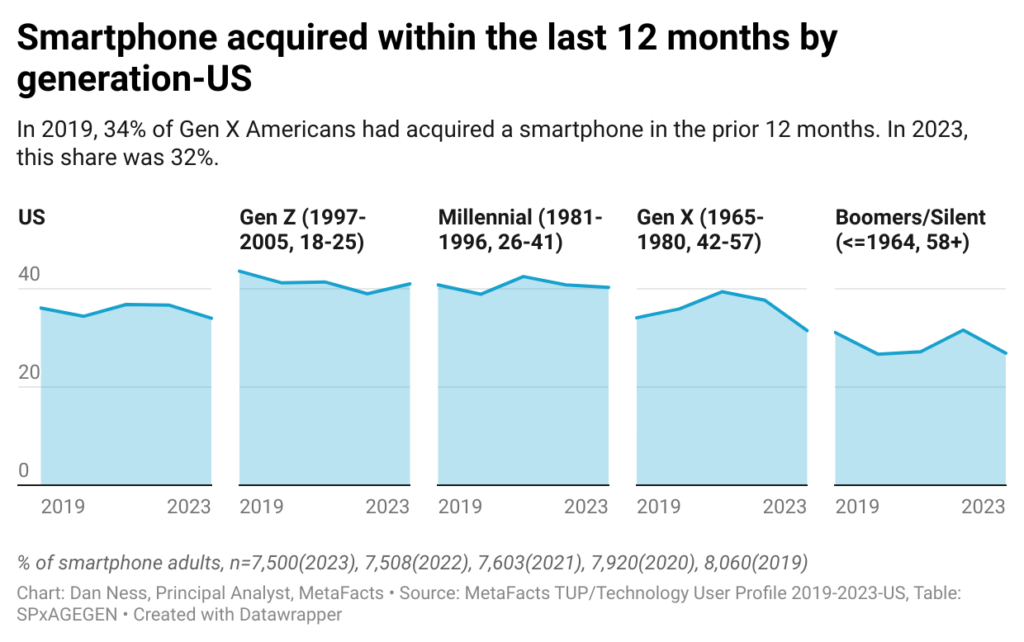Worldwide and in each country surveyed, the most-used combination of devices is to have a home computer, a smartphone, and no tablet. Having all three of these or only a smartphone are 2nd and 3rd and nearly equal. In Germany and China, using only a smartphone is ranked a distant 3rd. Conversely, in Japan, using all three is a distant 3rd. There is no significant difference by age group. Report [TUP_doc_2024_0125_comb] in TUP Lenses: Devices; PCs; Mobile Phones; Tablets
Smartphone hours exceed computer hours in most countries
Adults spend more time using smartphones than computers in most countries surveyed. Online Americans use their smartphones for 5.1 billion hours per week and computers – at home, work, school, or others – for 4.5 billion hours per week. In Germany, online adults use their smartphones, computers, and tablets for a total of 2.8 billion weekly hours, half of which are while using computers.
This MetaFAQs reports on the billions of weekly hours adults use their smartphones, computers, and tablets in the US, UK, Germany, Japan, and China. Report [TUP_doc_2024_0123_hour] in TUP Lenses: Devices; PCs; Mobile Phones; Tablets; Activities
Half of Americans use a smartphone for work
During the pandemic, the rapid flight to health, safety, and remote work caught many employers’ IT departments unprepared. Many workers did not have employer-provided computers or even home-owned ones, although the majority had smartphones. At the same time, much of the online population was already migrating many of their everyday activities away from computers to smartphones. Consequently, roughly half of online adults in the US and UK, and over 40% of those in Germany and Japan, regularly use their smartphones for work-related activities.
This MetaFAQ reports on the percentage of online adults that use a smartphone for a range of work-related activities, from checking email and participating in online meetings to phone and video calls. Report [TUP_doc_2024_0123_spwt] in TUP Lenses: Mobile Phones; Activities; Communication; Work/Life Balance
Youth using used smartphones
Economic pressures have supported younger adults, often with lower employment rates and limited funds, in turning toward acquiring technology from friends, family, or the refurbished device market. Refurbished or used smartphones are more widely used in the UK than in many other countries. Usage is especially high among adults aged 18 to 24 as compared to other age groups, a finding that is consistent across the US, Germany, the UK, Japan, and China. Generally, the use of a used/refurbished smartphone shrinks with age.
This MetaFAQs reports on the percentage of smartphone users who are using a used/refurbished smartphone by country. Report [TUP_doc_2024_0121_yref] in TUP Lenses: Devices; Mobile Phones; User Profile
Family size influences connected device use
In larger households, adults tend to spend more time on digital devices compared to those in smaller households. Adults in larger households use their connected devices more hours per week than those in smaller households. This pattern holds among online Americans, Britons, Japanese, and Chinese. Among German adults, the pattern is bimodal, with usage highest among German adults with 3 persons in their household.
This MetaFAQs reports on the average (mean) weekly hours online adults use their connected devices (computers, smartphones, tablets) during a week. Report [TUP_doc_2024_0119_busy] in TUP Lenses: Devices; PCs; Mobile Phones; Tablets; User Profile; Households
Smartphone replacement delays widespread across many countries and generations
Dan Ness, Principal Analyst, MetaFacts, January 15, 2024
Summary
Across the US, Germany, Japan, and China, a declining share of adults acquired smartphones in the prior year. Only in the UK have we seen a recent expansion of smartphone buyers. Gen Z adults are showing the widest variation, partly due to their rapidly shifting employment statuses and financial situations since the onset of the pandemic.
This MetaFAQs reports on the percentage of online adults who have acquired a smartphone in the prior 12 months split by country and age generation.
US smartphones freshen up among later generations
- Later generations of Americans have continued to use newer smartphones than earlier generations, with roughly 40% having acquired a smartphone in the prior year from 2019 through 2023
- Following the onset of the pandemic, Gen X updated their smartphones through 2021 only to then stall replacement such that a lower share have new smartphones than those who did in 2019
- The Boomer/Silent generations were already the last to be using new smartphones, and after a brief burst in 2022, they have since returned to having a smaller share of those with a new smartphone

Remote workers continue using devices for the most hours
Workers who work from home even part of the time use connected devices for more hours than those workers who never work remotely. The gap in hours is substantial, nearly 50% higher among American remote workers and even higher among those in Germany, Japan, and the UK.
In addition to direct productivity gains by reducing time for commuting and preparing to be in a workplace, remote workers can also spend more time using devices to do their work and to communicate and collaborate with others. Also, the occupations with higher rates of remote work tend to be information-based. Conversely, those workers who never work remotely often have occupations that require an in-person presence, which may preclude the use of connected devices.
This MetaFAQ reports the average (mean) number of weekly device hours among workers in the US, Germany, UK, Japan, and China, with devices including work computers, home computers, smartphones, and tablets. Report [TUP_doc_2023_1229_prot] in TUP Lenses: Devices; User Profile; Work/Life Balance
iPhones are strongest among younger adults in most countries
Apple’s continued emphasis on a youthful market continues to bear fruit. The highest penetration of Apple iPhones is among adults aged 18 to 24 across all countries surveyed. This is especially notable in Germany, where Google Android phones have dominated the market for many years. Conversely, iPhones have much lower penetration rates among adults aged 50 and up, except in the US, where rates among older adults are only somewhat lower than average.
This MetaFAQs reports on the percentage of online adults using an Apple iPhone split by age group and country. Report [TUP_doc_2023_1217_ipho] in TUP Lenses: Mobile Phones; User Profile; Technology Ecosystems
UK tech buyers boost buying while China’s elites hang on
The global landscape has witnessed significant shifts in consumer purchasing behavior due to the impact of the pandemic and broader economic changes. This transformation extends to acquiring tech products such as smartphones, computers, tablets, and game consoles. With the rapid transition to remote work, many individuals proactively invested in personal computing devices to enhance their productivity rather than relying on their employers for equipment provision.
Conversely, individuals facing reduced working hours or economic uncertainty opted to postpone their tech purchases. On a global scale, the mean age of a technology user’s primary device has exhibited relative stability, averaging between 1.9 and 2.1 years old over the past five years. However, a closer examination reveals notable variations across different countries.
The affluent and highly educated among China’s population has consistently maintained access to the latest tech devices. Nevertheless, a recent delay in 2023 has cast uncertainty on their leading position, potentially aligning them with the global average in the near future. In contrast, consumers in the UK, who amidst Brexit and the pandemic deferred tech device purchases, have demonstrated a two-year consecutive uptick in acquisitions. Consequently, their average device age now ranks second among surveyed countries.
Meanwhile, online adults in Germany and Japan have displayed a penchant for holding onto their primary devices longer compared to their international counterparts. These nuanced trends offer valuable insights for technology marketers, researchers, analysts, and industry professionals seeking to navigate evolving consumer preferences and market dynamics.
This MetaFAQs reports on the mean age of the respondent’s primary device – a smartphone, computer, tablet, or game console – by country from 2018 through 2023. Report [TUP_doc_2023_1207_yeat] in TUP Lenses: Devices; PCs; Mobile Phones; Tablets
Stronger tech buying plans among remote workers
Stronger tech buying plans among remote workers – Workers working from home have substantially stronger purchase plans than workers who never work from home. To be able to work effectively, they need sufficient technology to enable communication, collaboration, comfort, and computing. Based on their recent survey responses, their technology needs are not fully satisfied.
This MetaFAQs reports on the purchase plans for computers, tablets, printers, consumer electronics, and other technology products, contrasting workers who work from home versus those who do not by country. Report [TUP_doc_2023_1129_plan] in TUP Lenses: Devices; PCs; Mobile Phones; Tablets; Consumer Electronics; Printers; Work/Life Balance

